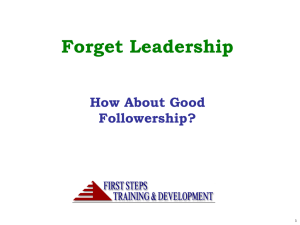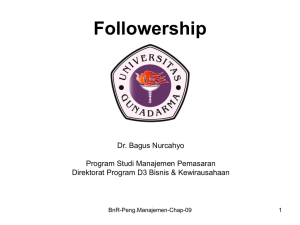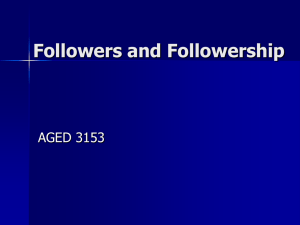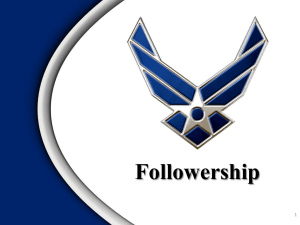An Exploration of Followership
advertisement
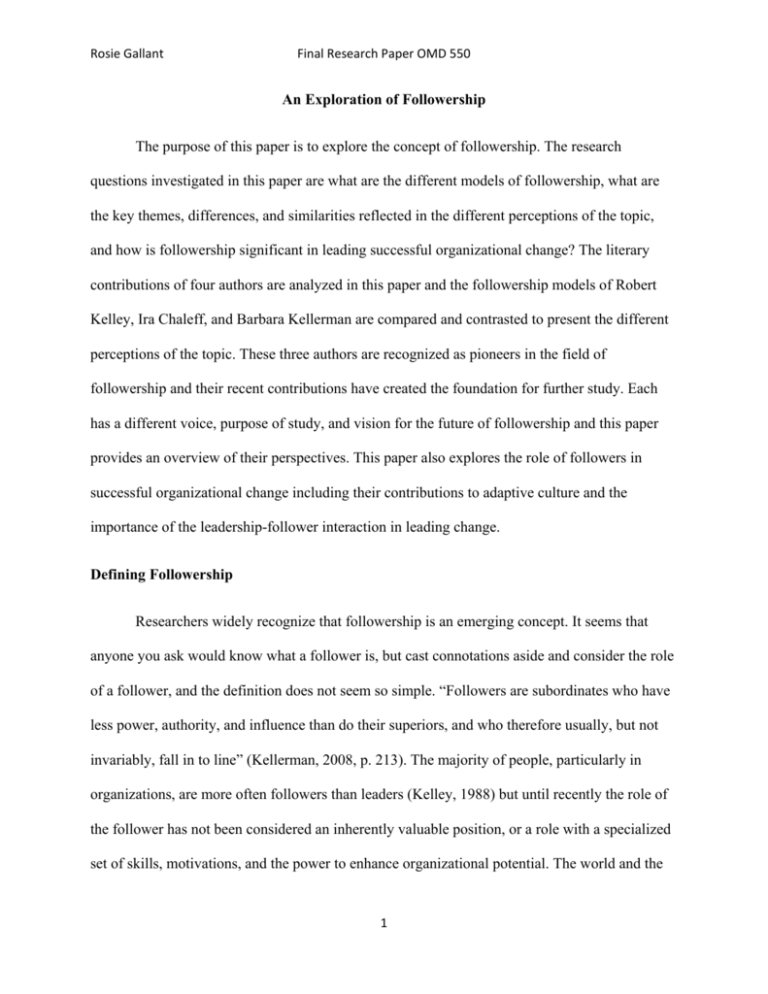
Rosie Gallant Final Research Paper OMD 550 An Exploration of Followership The purpose of this paper is to explore the concept of followership. The research questions investigated in this paper are what are the different models of followership, what are the key themes, differences, and similarities reflected in the different perceptions of the topic, and how is followership significant in leading successful organizational change? The literary contributions of four authors are analyzed in this paper and the followership models of Robert Kelley, Ira Chaleff, and Barbara Kellerman are compared and contrasted to present the different perceptions of the topic. These three authors are recognized as pioneers in the field of followership and their recent contributions have created the foundation for further study. Each has a different voice, purpose of study, and vision for the future of followership and this paper provides an overview of their perspectives. This paper also explores the role of followers in successful organizational change including their contributions to adaptive culture and the importance of the leadership-follower interaction in leading change. Defining Followership Researchers widely recognize that followership is an emerging concept. It seems that anyone you ask would know what a follower is, but cast connotations aside and consider the role of a follower, and the definition does not seem so simple. “Followers are subordinates who have less power, authority, and influence than do their superiors, and who therefore usually, but not invariably, fall in to line” (Kellerman, 2008, p. 213). The majority of people, particularly in organizations, are more often followers than leaders (Kelley, 1988) but until recently the role of the follower has not been considered an inherently valuable position, or a role with a specialized set of skills, motivations, and the power to enhance organizational potential. The world and the 1 Rosie Gallant Final Research Paper OMD 550 organizations in it have been viewed through the leader-centric lens (Kelley, 2008) and little attention has been paid to those who do not lead. Followership recognizes that followers can be in a position to better recognize the day to day events within an organization (Kelley, 2008), that organizations can actively cultivate good followers, and that sometimes following is more difficult than leading (Bennis, 2010). Followership Models Robert Kelley Kelley (1988) distinguishes followers in terms of their behavior and personality attributes and defines the different styles of followership by considering two different behavioral dimensions: one dimension measures the degree to which followers think independently and critically and the other assesses the level of engagement whether active or passive in the organization. Based on these two dimensions, Kelley defines five basic styles of follower; the sheep, the yes people, the alienated, the pragmatics, and the star followers. Each exhibits a different degree of independent thinking and organizational engagement and differs in their motivations. The following is a basic assessment of each follower type according to Kelley (1988): 1. The sheep are passive in their thinking and engagement and are motivated by their leader rather than themselves. 2. The yes-people also allow their leader to do most of the thinking and acting for them but are generally positive and always on the leader’s side. 3. In contrast, the alienated are predominantly negative but think more independently. They think for themselves but do not contribute to the positive direction of the organization. 4. The pragmatics exhibit a minimal level of independent thinking and engagement as they are more willing to exert energy and get involved when they see where the direction of 2 Rosie Gallant Final Research Paper OMD 550 the situation is headed. The pragmatics, thus, lack in demonstrating critical thinking and are motivated by maintaining the status quo. 5. Finally, the star followers think for themselves, have positive energy, and are actively engaged. They agree with and challenge their leaders. Kelley’s (1988) model focuses on the role of followers in an organization and creates a framework for identifying the different types. Through his assessment, organizations are able to recognize where the different perceptions and negative connotations of followers have developed and to consider the importance of the positive followership styles that exist (Kelley, 2008). He conceptualizes that effective followership exhibits a variety of qualities including the ability of followers to manage themselves, build on their own competence, exhibit commitment to the organizational purpose, and are courageous, honest, and credible (Kelley, 1988, p. 3). Kelley (1988) argues that the same qualities that make effective leaders are those that make effective followers and emphasizes the importance and purpose of followers. He states that “we need to view followers as the primary defenders against toxic leaders of dysfunctional organizations” (Kelley, 2008, p. 14). In general, Kelley places significant emphasis on the necessity and how-to ability of organizations to cultivate effective followers, how to teach people to stand up and prepare them to be successful. Ira Chaleff Chaleff’s (2008) model also focuses on followership in the workplace. Like Kelley, Chaleff conceptualizes how organizations can equip the everyday workers with the skills and mindsets required to be effective followers, and develops an even stronger framework for followership development. Chaleff also names the power that followers exhibit in their different 3 Rosie Gallant Final Research Paper OMD 550 qualities and distinguishes that power as courage. His Courageous Follower model reveals five different dimensions of attitudes and behaviors: 1. The courage to support the leader 2. The courage to assume responsibility for common purpose 3. The courage to constructively challenge the leader’s behaviors 4. The courage to participate in any transformation needed 5. And the courage to take a moral stand when warranted to prevent ethical abuses, (p. 72) From these different dimensions of attitudes and behaviors, Chaleff (2008), differentiates four styles of followership based on the degree to which followers have the courage to support or the courage to challenge the leader. Like Kelley (1988), Chaleff divides these styles in to groups: 1. The resource style of followership exhibits low support and low challenge. 2. The individualist style represents low support and high challenge. This follower will speak up but typically takes a position opposed to the majority. 3. The implementer style demonstrates high support and low challenge. 4. The partner style is characterized by high support and high challenge, assuming full responsibility for their actions and acting accordingly. Challef (2008) and Kelley’s (1988) models are very similar; each identifies the styles of followership by considering the levels of independent thinking and organizational engagement. Chaleff’s emphasis on courage is similar to Kelley’s perception that followers are essential in limiting toxic leaders, but Chaleff develops a stronger context for evolving and encouraging followers to be more effective. He stresses the follower potential and purpose to “influence upward” (Chaleff, 2008, p. 82) in order to transform the organizational culture. He states that “once people have a sense of the range of follower styles and of their own tendency, they need to connect these to situations they encounter in organizational settings” (Chaleff, 2008, p. 77), and offers examples of how organizations have used this exercise with success. Furthermore, Chaleff 4 Rosie Gallant Final Research Paper OMD 550 more specifically establishes that “both leaders and followers serve a common purpose, each from their own role” (p. 71). In general, Chaleff’s model provides a more in depth “how-to” for organizations to evolve their followers and transform their culture. Barbara Kellerman Kellerman (2008) provides a more worldview of followership and takes the concept outside just the organizational perspective. Like Kelley, Kellerman positions follower styles in a more hierarchical method, placing followers on a continuum of low engagement to absolutely committed. Kellerman’s model, however, provides a more holistic view of followers through conceptualizing followers in relation to leaders and in relation to other followers. She identifies five different followership styles: 1. Isolates are completely detached and do not know or care about their leaders. For example, “Americans who are eligible to vote but never do” (Kellerman, 2008, p. 86). 2. The bystanders observe but do not participate, they typically stand aside. Kellerman (2008) offers the powerful example of German followers during the Holocaust. 3. Participant followers are a bit more engaged. They either favor their leaders and organizations or are clearly opposed. 4. Activists feel strongly and act accordingly. 5. And diehards are deeply devoted to their leaders. Their followership and devotion defines who they are and determines what they do. Kellerman’s main focus is clearly on the level of engagement. She asserts that the level of engagement is the single most important factor in differentiating followership styles (Kellerman, 2008). In their respective contributions, both Kellerman (2008) and Chaleff (2008) indicate that dividing followers in to types allows another lens of perception in to how people can transform and create transformations. From Chaleff’s perspective, followers can transform the 5 Rosie Gallant Final Research Paper OMD 550 organizational culture, the norms and behaviors of an organization, and from Kellerman’s perspective, people with less authority can make a difference in the world over time. To Chaleff, these transformations require courage to support or challenge leaders and to Kellerman they require a level of engagement to influence the system. To finalize the comparison of the three different models, it is important to note that each author agrees that there are different styles of followership, that there is a difference between effective and ineffective followership, and that followers can and should influence their leaders. Fear and Courage Fear and courage are reoccurring themes in followership literature. Kellerman (2008) alludes to the concept in her example of the “Never Follow” campaign 2002 for Audi cars (p.3). She states that “Never Follow tapped into a fear rooted deep in the American psyche” (Kellerman, 2008, p. 3), people are afraid to be followers and followers fear speaking up against their leaders, but as Chaleff (2008) states, “fear is the necessary condition for displaying courage” (p. 80). Courage does not appear to be an inherent quality of followers, but a skill learned and an essential attribute in influencing leaders and organizations. Kelley (1988) emphasizes that organizations and leaders need to help people find personal courage and teach them that followership includes “courageous conscience” (p. 14). In more detail, Chaleff stresses that it is the courage of the followers two levels below leaders that have the potential to influence a situation. Toxic leaders are everywhere in organizations all over the world and as Bennis (2010) states in his portrayal of the dance between leaders and followers , good followers need to speak truth to power, speak up against their leaders, and leaders need to reward that courage. Essentially, followership appears to be a dance between fear and courage and if 6 Rosie Gallant Final Research Paper OMD 550 organizations can tap in to the recognition of followership, then they can manage another tool for organizational potential and transformational change. The Future of Followership Each of the authors assessed offers examples of the future potential for exploiting followership. Both Chaleff and Kelley conceptualize followership from an organizational perspective but allude to the larger impact it will or can have on the world. For example, Chaleff (2008) connects the concept of followers with courage to moving forward as a culture. Both Kelley and Kellerman also offer examples of how understanding followership can have positive impacts on organizational change and the world and how it is important to recognize this now. Kelley states that “in today’s flatter, leaner organization, companies will not succeed without the kind of people who take pride and satisfaction in the role of supporting player” (Kelley, 1988, p. 7). As the field of followership emerges, organizations are beginning to catch on. From a more worldly perspective, Kellerman (2008) connects the growing awareness of sustainability to a growing group of participant followers, a group with the ability to affect social and environmental change. Recognizing these followers, whether at an organizational or international level is essential in harnessing transformational change. Untapped Followership Potential Another reoccurring theme in each of the author’s contributions is a call for further research in the field of followership. Kelley (2008) most specifically asks the question “how do we unlock the practical applications of our knowledge about followership?” (p. 10). He suggests that followership can help us address larger world issues such as understanding the role of suicide bombers if we knew how to determine what motivates their followership and what type 7 Rosie Gallant Final Research Paper OMD 550 of followers they are (Kelley, 2008). Chaleff (2008) also agrees with Kelley that there are still answers waiting to be unlocked in the concept of followership, particularly in understanding world events. He questions what insights can be gained about the roles of people through understanding followership and calls for more research (Chaleff, 2008). The Role of Followership in Organizational Change Organizational change can not occur without a change in the organization’s culture, and a change in culture occurs through a change in leadership and governance (Doppelt, 2010). Followership can thus serve as an effective process in harnessing organizational change, as effective followers impact the adaptive culture of an organization through both challenging and supporting leaders. According to Bennis (2010), good followers “see the importance of speaking out” (p. 2) and leaders can trust good followers to tell the truth. Developing good followers is thus an effective practice in transforming organizational culture. In an adaptive culture, employees are engaged in the purpose and vision of the organization and the issues within the system are named, openly discussed, and confronted. If good followers have the courage to speak out and strengthen their enthusiastic, self-reliant participation in the organizational goal (Kelley, 1988), than an adaptive culture is more likely and is inevitably a less likely place for “toxic leaders”. According to Doppelt’s model of organizational change, successful change requires three fundamental principles: the presence of tension within the system, a sense of self efficacy amongst employees, and a two to one ratio of benefits to downsides (Doppelt, 2010). The leadership-followership interaction relates to these principles in a variety of ways. Good followers challenge their leaders and organizations (Kelley, 2008), creating tension that can be 8 Rosie Gallant Final Research Paper OMD 550 effectively managed for successful change if organizations understand how to cultivate the courage required. Good followers also exhibit a sense of self-efficacy, a quality that commands the independent, critical thinking of Kelley’s star followers (Kelley, 1988). To conclude, if individuals, groups, or organizations can recognize the followership concept and take charge of the methods for cultivating good followers, then they can effectively manage the dance between leaders and followers (Bennis, 2010) to enact successful organizational change. 9 Rosie Gallant Final Research Paper OMD 550 References Bennis, W. (2010). Art of Followership. Leadership Excellence, 27(1), 3-4. Chaleff, I. (2008). Creating new ways of following. The art of followership: how great followers create great leaders and organizations (1st ed., pp. 67-87). San Francisco, CA: JosseyBass. Doppelt, B. (2010). Leading change toward sustainability: A change management guide for business, government, and civil society (2nd ed.). Sheffield, UK: Greenleaf Publishing. Kellerman, B. (2008). Followership: how followers are creating change and changing leaders (1st ed.). Boston, MA: Harvard Business Press. Kelley, R. (2008). Rethinking followership. The art of followership: how great followers create great leaders and organizations (1st ed., pp. 5-15). San Francisco, CA: Jossey-Bass. Kelley, R. E. (1988). In Praise of Followers. Harvard Business Review, 66(6), 142-148. 10

